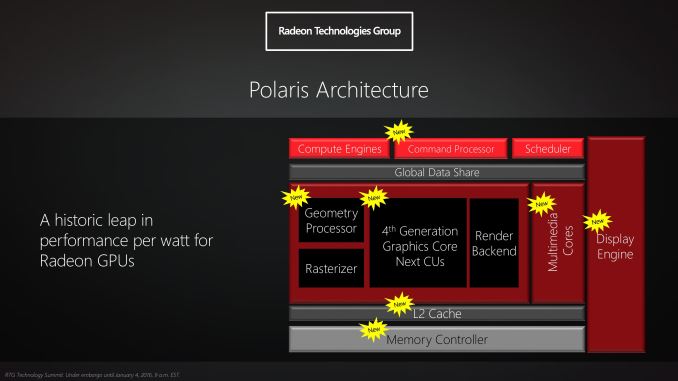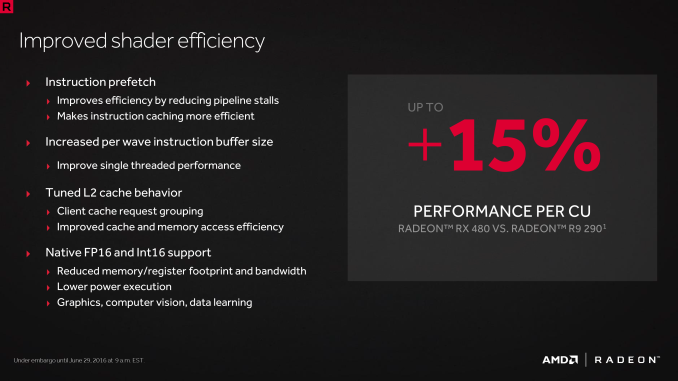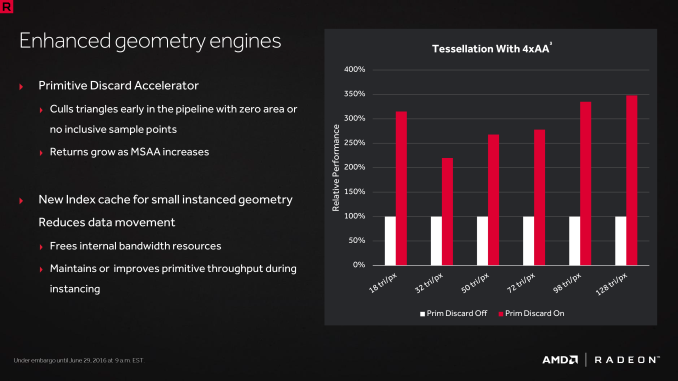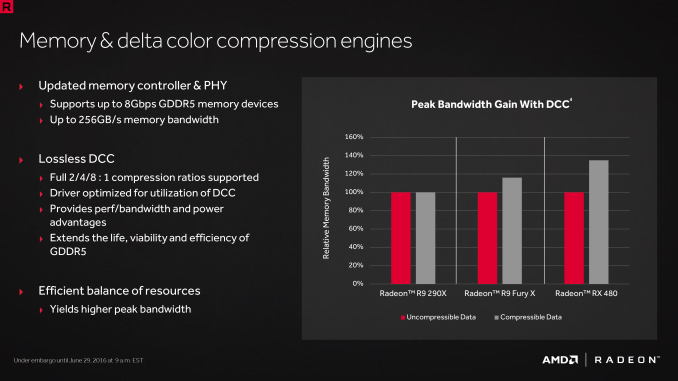The AMD Radeon RX 480 Preview: Polaris Makes Its Mainstream Mark
by Ryan Smith on June 29, 2016 9:00 AM ESTThe Polaris Architecture: In Brief
For today’s preview I’m going to quickly hit the highlights of the Polaris architecture.
In their announcement of the architecture this year, AMD laid out a basic overview of what components of the GPU would see major updates with Polaris. Polaris is not a complete overhaul of past AMD designs, but AMD has combined targeted performance upgrades with a chip-wide energy efficiency upgrade. As a result Polaris is a mix of old and new, and a lot more efficient in the process.
At its heart, Polaris is based on AMD’s 4th generation Graphics Core Next architecture (GCN 4). GCN 4 is not significantly different than GCN 1.2 (Tonga/Fiji), and in fact GCN 4’s ISA is identical to that of GCN 1.2’s. So everything we see here today comes not from broad, architectural changes, but from low-level microarchitectural changes that improve how instructions execute under the hood.
Overall AMD is claiming that GCN 4 (via RX 480) offers a 15% improvement in shader efficiency over GCN 1.1 (R9 290). This comes from two changes; instruction prefetching and a larger instruction buffer. In the case of the former, GCN 4 can, with the driver’s assistance, attempt to pre-fetch future instructions, something GCN 1.x could not do. When done correctly, this reduces/eliminates the need for a wave to stall to wait on an instruction fetch, keeping the CU fed and active more often. Meanwhile the per-wave instruction buffer (which is separate from the register file) has been increased from 12 DWORDs to 16 DWORDs, allowing more instructions to be buffered and, according to AMD, improving single-threaded performance.
Outside of the shader cores themselves, AMD has also made enhancements to the graphics front-end for Polaris. AMD’s latest architecture integrates what AMD calls a Primative Discard Accelerator. True to its name, the job of the discard accelerator is to remove (cull) triangles that are too small to be used, and to do so early enough in the rendering pipeline that the rest of the GPU is spared from having to deal with these unnecessary triangles. Degenerate triangles are culled before they even hit the vertex shader, while small triangles culled a bit later, after the vertex shader but before they hit the rasterizer. There’s no visual quality impact to this (only triangles that can’t be seen/rendered are culled), and as claimed by AMD, the benefits of the discard accelerator increase with MSAA levels, as MSAA otherwise exacerbates the small triangle problem.
Along these lines, Polaris also implements a new index cache, again meant to improve geometry performance. The index cache is designed specifically to accelerate geometry instancing performance, allowing small instanced geometry to stay close by in the cache, avoiding the power and bandwidth costs of shuffling this data around to other caches and VRAM.
Finally, at the back-end of the GPU, the ROP/L2/Memory controller partitions have also received their own updates. Chief among these is that Polaris implements the next generation of AMD’s delta color compression technology, which uses pattern matching to reduce the size and resulting memory bandwidth needs of frame buffers and render targets. As a result of this compression, color compression results in a de facto increase in available memory bandwidth and decrease in power consumption, at least so long as buffer is compressible. With Polaris, AMD supports a larger pattern library to better compress more buffers more often, improving on GCN 1.2 color compression by around 17%.
Otherwise we’ve already covered the increased L2 cache size, which is now at 2MB. Paired with this is AMD’s latest generation memory controller, which can now officially go to 8Gbps, and even a bit more than that when oveclocking.














449 Comments
View All Comments
stereopticon - Wednesday, June 29, 2016 - link
the gtx 970's price could easily be dropped to 240 to competesmilingcrow - Wednesday, June 29, 2016 - link
In the UK the 970 is already cheaper than the RX 480 8GB if you shop around which is where it should be priced I think.The RX 480 only has one redeeming feature but that's an important one; PRICE.
ptmnc1 - Wednesday, June 29, 2016 - link
Well, it *could*, I suppose. But the 970 is a 398mm² chip and the 480 is a 232mm² chip so AMD can make 1.7x as many from the same wafer even before accounting for yields. With similar memory systems there's no way for nVidia to win a price war at this performance level with its 28nm parts.DigitalFreak - Wednesday, June 29, 2016 - link
AMD has no monies to fight a price war. Nvidia could drive them out of the market right now if they wanted to. They won't because of monopoly concerns.ptmnc1 - Wednesday, June 29, 2016 - link
nVidia can't flog 970s below cost without various anti-dumping laws kicking in as well as the risk of having their company disassembled. Plus AMD would still be making a profit at that point.Yojimbo - Thursday, June 30, 2016 - link
I'm pretty sure that NVIDIA wouldn't have to sell the 970 for below cost to use it to compete or even undercut the current MSRP of the RX 480. NVIDIA's profit margins are significantly higher than AMD's to begin with. If NVIDIA prices the GTX 970 at just below the price as the RX 480, they probably sell more of them than AMD sells of the RX 480s. A price of the 970 GPU to AIB partners which would allow them to sell their card for $180 should not be below cost. I really don't know how such accounting works, but I am guessing that most of the research, development, and validation costs have already been amortized. Production cost of the chip really is not that much, comparitively. Surely regulators must recognize a cost advantage of a long-run production of a product.fanofanand - Thursday, June 30, 2016 - link
I'm not sure anti-dumping laws apply to obsolete (based on not being the latest) hardware. How else would a company be expected to clear out existing inventory prior to a product refresh?ptmnc1 - Thursday, June 30, 2016 - link
Yojimbo: The 970 has almost exactly the same memory system as the 4GB 480, the only differences in manufacturing costs are going to be the other parts of the board (e.g. VRMs) and the chip itself. The principal cost difference is going to be the chip, and when it's a 232mm² chip vs a 398mm² chip, the latter is going to cost a lot more to make even if yields on Samsung's 14LPP aren't as great as TSMC's 28nm: as long as they're not catastrophically worse (and there's no indication that's the case), there's just no way to build a 970 cheaper than a 4GB 480.On monopolies, you don't have to abuse one in order to attract a lot of undesirable attention from regulators.
fanoffanand: There's a difference between clearing existing obsolete inventory and deliberately manufacturing new inventory at a loss for the purpose of pushing a competitor out of business.
Yojimbo - Thursday, June 30, 2016 - link
The major cost of a chip is research, development, testing, and validation, not manufacturing costs. I assume these costs must be amortized over the life of the product. I am guessing that NVIDIA has already mostly done so, because they have sold a whole lot of chips already. You are worried about dumping, well how can the government come in and say NVIDIA is selling below cost when their research, development, testing, and validation costs logically apply over a run of 2 years, during which they already sold a high volume of chips?Regardless of whether it costs more or less for NVIDIA to make a 970 than AMD an RX 480 (I agree that the AMD RX 480 production costs should be lower), I feel confident in saying that NVIDIA doesn't need to sell at below cost to sell a 970 at a price below $200.
"On monopolies, you don't have to abuse one in order to attract a lot of undesirable attention from regulators."
Regulators don't just sit there and watch everything. NVIDIA would have to be sued for abuse of power, i.e., some company would need to be willing to spend money to oppose NVIDIA. If NVIDIA does not abuse its market position they shouldn't be too concerned with losing such a suit. If they don't plan on making any aquisitions in the GPU space then i think they don't need to worry about regulators. I'm mainly just repeating what I already said here, but you aren't saying what sort of "undesirable attention" you see NVIDIA getting or how it will affect them, so I'm not sure what else I can do.
fanofanand - Friday, July 1, 2016 - link
Nvidia isn't currently manufacturing new 970s.